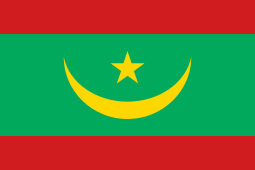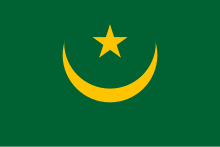Flag of Mauritania
 | |
| Use | National flag and ensign |
|---|---|
| Proportion | 2:3 |
| Adopted | 15 August 2017 |
| Design | Two red stripes flanking a green field; charged with a golden upward-pointed crescent and star |
| Designed by | Moktar Ould Daddah |
 | |
| Use | Presidential standard |
| Proportion | 2:3 |
| Design | The seal of Mauritania centered on a field of white. |
The national flag of Mauritania (علم موريتانيا) is a green field containing a gold star and crescent, with two red stripes at the top and bottom of the field. The original national flag was introduced under the instructions of President Moktar Ould Daddah[1] and the constitution of 22 March 1959 and was officially adopted on 1 April 1959.[2]
On 5 August 2017, a referendum was held by president Mohamed Ould Abdel Aziz to change the national flag, abolish the senate, and other constitutional amendments.[3] The referendum was successful, and the new flag, including two red horizontal stripes, which represent "the efforts and sacrifices that the people of Mauritania will keep consenting, to the price of their blood, to defend their territory", was adopted in time for its first raising on 28 November 2017, the 57th anniversary of Mauritania's independence from France.[4]
It is one of the two flags of a currently Arabic-speaking country (the other being Egypt) that uses a shade of yellow. Also, like Egypt, the yellow colour is used in the central emblem (the crescent for Mauritania's flag and the Eagle of Saladin for Egypt's flag).
Design
[edit]Green, gold and red are considered Pan-African.[5] Green is also used to symbolise Islam, and the gold is for the sands of the Sahara desert. The red stripes, which were added to the flag in 2017, represent "the efforts and sacrifices that the people of Mauritania will keep consenting, to the price of their blood, to defend their territory".[6] The crescent and star are symbols of Islam, which is Mauritania's official and state religion.[2] There was no official specification or construction sheet for the exact relative measurements of the star and crescent, except the flag's measurements of 2:3, until May 2020.[7]
Specifications
[edit]
According to Kennach (government portal of Mauritania), the flag's elements are specified as:[8]
- Proportion = 2 : 3 and all following ratios are to width of the flag
- Width of red stripes = 20%
- Width of green area = 60%
- Width of the area of star and crescent = 40%
- Distance between lower red stripe and lower portion of the crescent = 10%
- Diameter of outer circle of the crescent = 75% (50% of length of the flag)
- Maximum width of the crescent = 10.2%
- Distance between maximum width of the crescent and base of the star = 10.7%
- Horns of the crescent are the left and right portions of outer circle
- Distance between upper red stripe and perpendicular vertex of the star = 10%
- Height of the star = 19.1% (i.e. diameter of the star becomes 21.1164%)
Colors scheme |
Green | Red | Yellow |
|---|---|---|---|
| CMYK | 86-5-95-0 | 11-100-100-4 | 1-13-100-0 |
| HEX | #00A95C | #D01C1F | #FFD700 |
| RGB | 0-169-92 | 208-28-31 | 255-215-0 |
Use
[edit]The design acts as the national flag of Mauritania and is also used in circular form as an aircraft roundel.[2]
Variants
[edit]Although the constitutional amendments only mentioned the addition of red bands, officials have been using different flag's models between the change in 2017 and the official construction sheet released in 2020.
-
Version with slight different color shades and position for star and crescent[12]
Legal basis
[edit]

The current constitution of 12 July 1991 specifies that:[13]
The national emblem is a flag with a crescent and a gold star on a green ground
— 12 July 1991, Constitution of Mauritania
Unlike the seal, the exact flag is specified, not merely the right for a law to specify it at some later date.[13] However, the flag has its official basis in the earlier constitution of 22 March 1959;[2] no changes were made when the country declared its independence in 1960.[14]
2017 redesign
[edit]In 2017, a red band at the top and bottom were added to symbolise "the efforts and sacrifices that the people of Mauritania will keep consenting, to the price of their blood, to defend their territory",[6] in a referendum on 5 August 2017, scheduled by president Mohamed Ould Abdel Aziz which contained among other constitutional amendments a modification of the national flag and anthem. First scheduled as part of a single vote, these changes proved controversial enough for them to be made into a separate vote on the same day as the vote on institutions.[15][16]
See also
[edit]References
[edit]- ^ France: Colonial Empire at Flags of the World. Jaume Ollé and Nozomi Kariyasu, 17 June 1998. Accessed 27 August 2009.
- ^ a b c d (Flag of) Mauritania at Flags of the World Accessed 27 August 2009.
- ^ "Mauritania votes to abolish senate by referendum". www.aljazeera.com. Retrieved 19 October 2023.
- ^ L’Assemblée nationale adopte le projet de loi portant description du drapeau de la RIM, Agence Mauritanienne d'Information, 12 October 2017. Accessed 28 August 2018.
- ^ Pan-African Colours at Flags of the World Accessed 27 August 2009.
- ^ a b Mauritania vows referendum to abolish Senate, change flag News 24, 23 March 2017
- ^ "Drapeau العلم - Kennach". www.kennach.gov.mr. Archived from the original on 13 June 2020.
- ^ "MAQUETTE DRAPEAU Grande dimension" (PDF) (in French).
- ^ Mauritanie: nouveau drapeau et nouvel hymne pour la fête nationale
- ^ "La ministre de l'éducation nationale et de la formation professionnelle reçoit l'ambassadeur de Tunisie". Archived from the original on 14 November 2019. Retrieved 1 February 2019.
- ^ "Le ministre de la défense présente aux députés le nouveau drapeau". Archived from the original on 2 February 2019. Retrieved 1 February 2019.
- ^ Flags of the World: Mauritania - Construction Sheet
- ^ a b "Mauritania - Constitution". International Constitutional Law. 12 July 1991. Retrieved 27 August 2009.
- ^ Whitney Smith (2001). Flag lore of all nations. Millbrook Press. p. 62. ISBN 9780761317531. Available at Google Books, here (accessed 27 August 2009).
- ^ "Mauritanie: un référendum pour supprimer le Sénat, changer de drapeau et d'hymne" [Mauritania: a referendum to abolish the Senate, change the flag and the anthem] (in French). afrique.le360. 4 November 2016. Retrieved 16 November 2016.
- ^ "Mauritania votes on controversial constitutional reform". Al Jazeera. 6 August 2017. Retrieved 6 August 2017.

![Version without modifications to the crescent or colours, shown to the national assembly in the 2017 debates[9][10][11]](http://upload.wikimedia.org/wikipedia/commons/thumb/a/af/Proposition_de_drapeau_de_la_Mauritanie_de_2017.svg/120px-Proposition_de_drapeau_de_la_Mauritanie_de_2017.svg.png)
![Version with slight different color shades and position for star and crescent[12]](http://upload.wikimedia.org/wikipedia/commons/thumb/2/27/Alternative_Flag_of_Mauritania.svg/120px-Alternative_Flag_of_Mauritania.svg.png)
